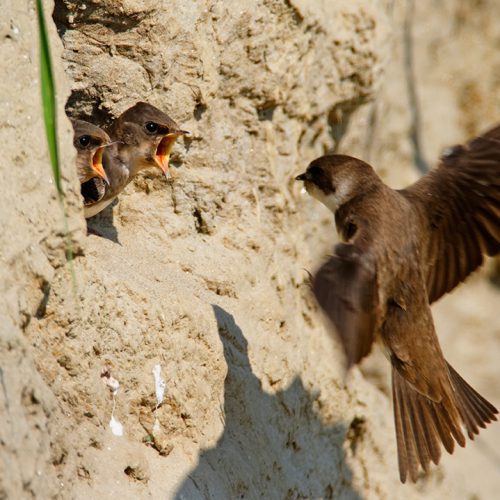Hírek
Monitoring of sand martin populations
The population of sand martins on the Drava fell by 75% over the last 30 years
An analysis conducted by WWF, in cooperation with the Natural History Society Drava, on the evening of the European day of bird watching (EUROBIRDWATCH 2016) showed that river bird populations have been somewhat stable over the last 10 years. However, an analysis of the monitoring results of river birds on the Mura, Drava and Danube confirmed the long-term trend of a decline in the number of birds.
WWF, together with the Croatian bird expert Darko Ivan Grlica of Natural History Society Drava, have been carrying out monitoring activities on those rivers since 2005. In total, 12 bird species have been monitored, including sand martin, bee-eater, kingfisher, common tern, tern, little tern, ringed plover, sandpiper, black stork, cormorant and white-tailed eagle. Data collection comprises the condition of their populations and habitats, so the organisations are able to react in time if populations should go down for some reasons.
"WWF Adria wants to raise public awareness about the river birds that live along the Mura, Drava and Danube. In particular, we want to pay attention to the sand martin which is the most endangered bird species along the Drava with constantly declining numbers. As a result, WWF and other NGOs declared the sand martin “Bird of the Year 2016”. They are most threatened by the construction of river dikes, and if we want to save them, we need to preserve the natural Drava River," said Ivana Korn Varga from WWF Adria.
The sand martin (Riparia riparia) is listed in the Red Book of birds in Croatia as being vulnerable (VU) to extinction. Human activities, such as the construction of hydropower plants, embankments or extensive agriculture, e.g. the use of pesticides cause a constant decrease in numbers. In the 80ies, the number of breeding pairs was estimated to be between 25.000 and 30.000 and the monitoring results from 2005-2016 showed a population decline of 40%, i.e. breeding pairs to numbers as low as 12.232 to 7.444. The lowest numbers were recorded in 2015, when only 3,939 breeding pairs were counted.
"The Drava, as any natural lowland river, meanders and naturally creates new habitats for sand martins. However, if this process stops due to e.g. the construction of river dikes, these habitats start to disappear. While Croatia has lost a huge amount of sand martins over the last years, there are still a considerable amount of birds present. This is thanks to the Drava’s ability to relatively quickly create new habitats (e.g. backwaters, shoals, oxbow lakes, steep banks and shoals), which are suitable for various bird species. Nevertheless, we have to protect the natural and living river, "warned Darko Ivan Grlica.
Especially in the upper reaches of the river Drava, the population of some bird species is constantly declining. The Danube has lost most species and for the Mura, every loss is significant as compared to the Drava and Danube it is not so rich in various species of birds.
"The Drava River is one of the rivers with the highest bird diversity, as a large part of its course, especially the part from Donja Dubrava to Osijek, is still mostly natural and free flowing. WWF advocates the sustainable management of rivers because this is the only way to preserve our rivers with all services that they offer to people. For example, one family sand martin eats up to 10.000 mosquitoes per day, to the delight of the local population," concluded Ivana Korn Varga from WWF Adria.


